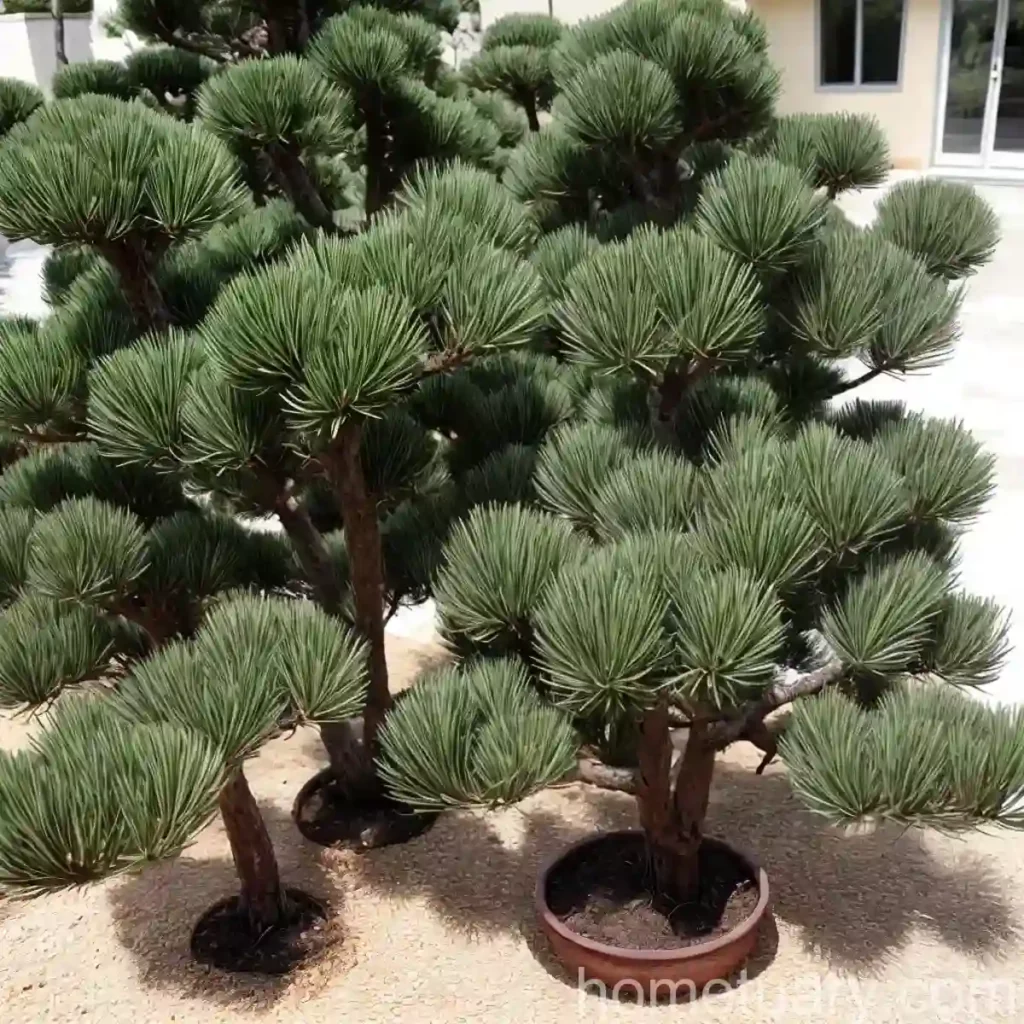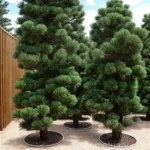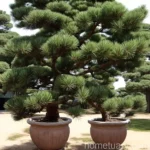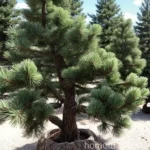Mugo Pine (Pinus mugo): A Comprehensive Guide
Introduction to Mugo Pine (Pinus mugo)
The Mugo Pine, scientifically known as Pinus mugo, is a versatile and adaptable evergreen conifer that belongs to the Pinaceae family. This species is native to the mountainous regions of Central and Southern Europe, including the Alps, Carpathians, and Balkans. It is a small to medium-sized tree with a compact and dense growth habit. The Mugo Pine is highly valued for its ornamental qualities and is widely utilized in landscaping and gardening due to its resilience and aesthetic appeal.

Image Source: Gardening Know How
Key Takeaways – Mugo Pine (Pinus mugo)
The Mugo Pine, with its numerous varieties and adaptability, offers a multitude of possibilities for landscape design, from ornamental features to erosion control. This comprehensive guide will walk you through its characteristics, cultivation, care tips, landscape uses, and more.
Characteristics of Mugo Pine
The Mugo Pine possesses several distinctive features that contribute to its popularity in landscaping and gardening. Here are some essential characteristics of the Mugo Pine:
Physical Characteristics
- Size: Mugo Pines typically range from 4 to 20 feet in height, depending on the variety.
- Needles: The needles of the Mugo Pine are dark green and densely packed in bundles of two, giving the tree a lush appearance.
- Cones: The tree produces small, egg-shaped cones that add visual interest and are often used for decorative purposes.
Growth Rate and Hardiness
- Growth Rate: Mugo Pines are known for their slow to medium growth rate, making them suitable for landscaping where consistent growth is desirable.
- Hardiness Zone: They are hardy in USDA zones 2 to 7, showing excellent performance in cold climates.
Growing Mugo Pine
The successful cultivation of Mugo Pine requires an understanding of its specific requirements and growth patterns. Whether you are considering planting them in your home garden or in a landscaping project, here are the key factors to consider:
Water
- Mugo Pines prefer a well-drained soil and are relatively drought-tolerant once established.
- Water young trees deeply once a week, especially during periods of dry weather. Mature trees may only require supplemental watering during extended droughts.
Sunlight
- Mugo Pines thrive in full sun to partial shade, with at least 6 hours of direct sunlight per day being ideal for optimal growth.
Soil Requirements
- They grow best in slightly acidic to neutral soil with good drainage. Sandy or loamy soils with adequate organic content are well-suited for Mugo Pines.
Hardiness Zone
- It is important to consider your specific hardiness zone when choosing to grow Mugo Pine. These trees can withstand cold temperatures, making them suitable for a range of climates.
Growth Rate and Size
- Depending on the variety, Mugo Pines exhibit slow to medium growth rates and have a compact, rounded form. Varieties such as Pinus mugo ‘Mops’ are ideal for gardeners seeking a smaller, more compact tree, while others like Pinus mugo ‘Mughus’ can attain larger sizes.
Pinus mugo Care Tips
To ensure the health and vitality of your Mugo Pine, proper care and maintenance are essential. Consider the following care tips to promote the well-being of your trees:
- Pruning: Mugo Pines respond well to shaping and selective pruning. Regularly remove dead or diseased branches to maintain the tree’s overall health and appearance.
- Fertilization: Apply a balanced fertilizer in the early spring to support healthy growth. Avoid over-fertilizing, as this can lead to excessive foliage at the expense of overall tree vigor.
- Mulching: A layer of organic mulch around the base of the tree helps retain soil moisture and suppress weed growth. Ensure the mulch does not come into direct contact with the trunk to prevent potential issues.
- Winter Care: While Mugo Pines are generally cold-hardy, providing winter protection such as burlap windbreaks for young or vulnerable trees can mitigate potential damage in harsh conditions.
Mugo Pine Varieties
The Mugo Pine encompasses a wide range of cultivated varieties, each with unique characteristics and applications in landscaping. Some popular Mugo Pine varieties include:
| Variety | Description |
|---|---|
| Pinus mugo ‘Mops’ | A compact, globe-shaped variety ideal for small spaces |
| Pinus mugo ‘Mughus’ | An upright, bushy form with a broad, spreading habit |
| Pinus mugo ‘Winter Gold’ | Notable for its yellow new growth in spring |
Pinus mugo Landscape Uses
The versatility and aesthetic appeal of the Mugo Pine make it a sought-after species for various landscaping purposes. Here are some common landscape uses of Mugo Pines:
- Foundation Planting: Their compact form and evergreen foliage make Mugo Pines suitable for planting around homes and buildings as foundation plants.
- Rock Gardens: The low-growing varieties are excellent choices for rock gardens, providing year-round greenery and visual interest.
- Hedges and Borders: Mugo Pines can be shaped into formal or informal hedges, adding structure and texture to garden borders.
Ornamental Features
- Decorative Cones: The small cones produced by Mugo Pines add ornamental value, often persisting on the tree for an extended period.
- Textured Bark: Some varieties feature interesting bark textures, adding visual appeal to the landscape even in the absence of foliage.
Pinus mugo Pruning Techniques
Pruning Mugo Pines is an essential aspect of their maintenance, helping to manage their shape, promote air circulation, and remove diseased or damaged branches. Here are some pruning techniques to consider:
- Selective Pruning: Identify and remove dead, diseased, or crossing branches to maintain the tree’s health and appearance.
- Shaping: Mugo Pines respond well to shaping, allowing you to create a desired form or maintain a compact growth habit.
- Timing: Prune Mugo Pines in late winter to early spring before new growth emerges, allowing the tree to heal and minimize stress.
Pinus mugo Diseases
While Mugo Pines are generally resilient, they can be susceptible to certain diseases under specific conditions. Understanding common diseases and their prevention is crucial in maintaining the health of your Mugo Pines.
Common Diseases
- Needle Blight: Needle blight, caused by fungal pathogens, can result in browning and premature shedding of needles. Prune affected areas and ensure proper spacing and airflow to reduce the risk of infection.
- Canker Diseases: Canker diseases can cause sunken, discolored areas on the trunk or branches, leading to dieback. Prune infected branches and maintain overall tree health to minimize susceptibility.
Pinus mugo Pests
While relatively resistant to pests, Mugo Pines can occasionally face issues with certain insects. Here are some common pests to be aware of:
Common Pests
- Pine Sawfly: These pests can defoliate Mugo Pines by feeding on the needles. Monitor for the presence of sawfly larvae and address infestations promptly.
- Pine Shoot Moth: The larvae of this moth can cause damage to new shoots and buds. Regular inspection and pruning of affected areas can help manage infestations.
Botanist’s Tips
As a botanist, here are some additional tips and insights for effectively caring for and appreciating Mugo Pines:
- Wildlife Habitat: Mugo Pines provide shelter and nesting sites for birds, as well as cover for small mammals, contributing to the biodiversity of garden and landscape settings.
- Mulching: Applying mulch around the base of Mugo Pines helps maintain soil moisture, regulates temperature, and provides a buffer against competing vegetation.
Fun Facts
To further appreciate the uniqueness of Mugo Pines, let’s explore some fascinating facts about these versatile trees:
- Bonsai Potential: Mugo Pines are popular choices for bonsai cultivation due to their adaptability and striking appearance in miniature form.
- Fragrance: When crushed or brushed against, the needles of Mugo Pines release a pleasant, resinous fragrance, adding to their sensory appeal.
Links to External Resources
For further information and resources on Mugo Pines, the following links are valuable references:
- American Conifer Society: Mugo Pine (Pinus mugo)
- The Morton Arboretum: Mugo Pine
- University of California Agriculture & Natural Resources: Mugo Pine
Conclusion
In conclusion, Mugo Pines, with their adaptability, ornamental features, and landscape versatility, are exceptional additions to gardens and outdoor spaces. Whether you are seeking a compact evergreen for a small garden, a focal point for a rockery, or a low-maintenance plant for a landscape border, Mugo Pines have much to offer. By understanding their specific care requirements, utilizing the diverse range of available varieties, and appreciating their unique characteristics, you can create stunning and resilient landscapes with the enduring beauty of Mugo Pines.
In this comprehensive guide, we have explored the characteristics, cultivation, care tips, landscape uses, and other essential aspects of Mugo Pines, providing a valuable resource for gardeners, landscapers, and enthusiasts. With proper consideration and thoughtful integration into your outdoor spaces, Mugo Pines can enrich and enhance the beauty of your surroundings, while also contributing to the ecological balance and biodiversity of the environment.
Remember, when choosing plants for your garden or landscape, it’s important to consider the specific requirements and growth habits of each species to ensure their successful establishment and long-term vitality. Through informed decision-making and attentive care, you can create thriving and visually captivating landscapes that bring joy and fulfillment for years to come.















